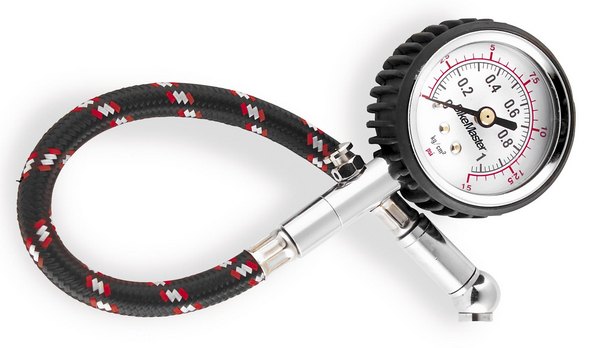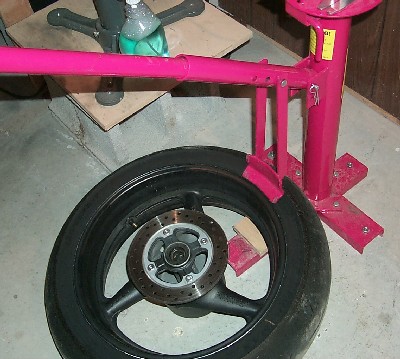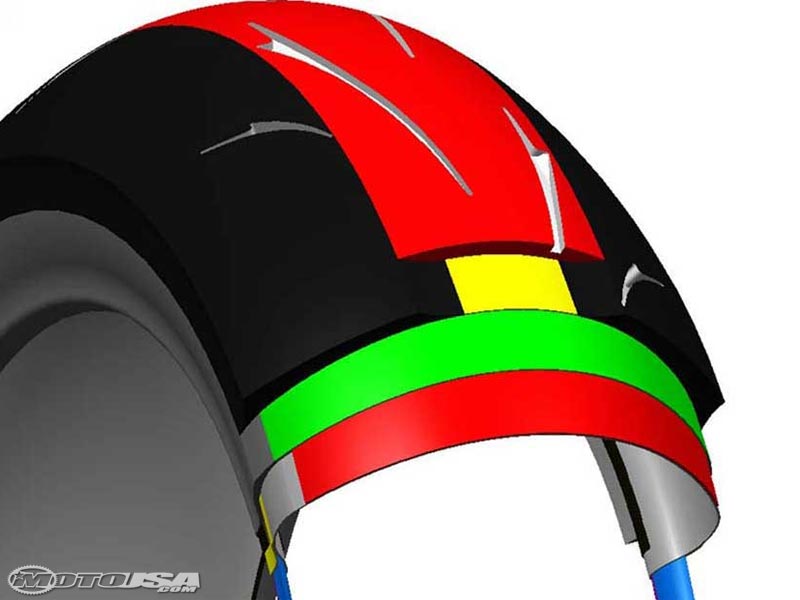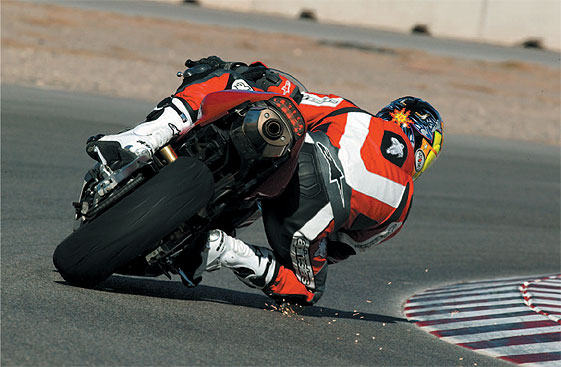
An often asked question is “what tire pressure should I be running”. The answer of course like so many things to do with motorcycling is not as simple as 36/41!!
The answer depends on what tires your running, what bike you’re running and in what way you’re intending to run. On the race track we run lower pressures, but why? On larger bikes you tend to run higher pressures. How low can you go? What are the other effects of having a tire pressure too high or low?
So let’s break this down into sections and then you might start to get a handle on each bit one at a time.
The Mechanics of a tire:
A motorcycle tire uses air pressure, together with a wire “bead”, to hold it onto the rim of your wheel. So first decision on pressure is what pressure range is safe before it “Pops” a bead and starts to come off?
The second consideration is about profile as a tire uses air pressure to maintain its rolling profile and too low a pressure will make the tire collapse and the bike handle differently, whilst too high a pressure will cause the tire to also hold the wrong profile and fall into corners whilst “skipping” across surface irregularities.
Ok so a modern tubeless rim and tire have great bead pressure holding on the tire and so will allow much lower pressures than a tubed tire. A tubed tire will not usually be safe below about 30PSI and will risk separation from the rim under load or at minimum the tire will spin and rip out the valve without locking devices (some off roader rims use just this technique to hold a tire on and stop it spinning at low pressures).

A tubeless tire has a lot more leeway for lower pressure and it becomes about the shape and profile of the tire (as far as mechanics go). Here the construction is very important.
A modern radial belted tire (steel or fibre) will holds its rolling shape a lot better than a bias tire which will start to expand and contract based on the wheel speed as well as roll laterally. Again I would not recommend dropping below 30-35 PSI for a Bias tire.
However a good radial tire will maintain a good profile much lower, sometimes down as low as 20-25PSI.

The top pressure for the tire should always be the manufacturers recommended pressure which is usually the fully loaded figure, beyond which the tire will begin running out of shape and also too cold.
Ok, so we now have some hard limits top and bottom. They are fairly easy to work out. Next step is how to work within that range for what we need.
Rolling Resistance and Heat:
Tires are made from rubber. Imagine that!!! And if you have read the previous article about grip and traction you’ll have realised that rubber has a co-efficient of friction (its grip) and also that that grip (CoF) varies according to the temperature of the rubber.
This is a fancy way of saying that tires are designed to operate at a certain temperature and below that they will not provide maximum grip, whilst above that they will start to wear too quickly as their tensile strength reduces.
What does this have to do with tire pressure? We’ll two things: A: heat in a tire is to do with flex and friction B: as a tire heats so does the air and therefore the pressure rises.
So first things first, lower pressures mean more flex which mean more heat generated faster. Lower pressures on a tire that is flexing and producing a lot of heat will expand up to reasonable pressures fairly quickly whereas with normal pressures to start you will end up with a slower heating cycle to start and later less grip as the tire gets too much pressure.
The above is the main reason we lower tire pressures for the track. They heat up quicker and therefore provide maximum grip earlier and also reach a more “normal” pressure and therefore shape once hot rather than over inflating.
Using a laser thermometer I have personally measured the heat build-up in tires and lower pressures do mean faster heat up, but not higher temperatures until the pressure is really low. Likewise higher pressures do mean a slower warm up and can actually mean the tire never reaches a proper operating temperature. Good for getting maximum fuel mileage and tire life but not so good for your life if you are relying on the grip to keep you safe.
Another point worth knowing is tire flex is also dependant on the weight of the bike and rider and also how aggressive the riding style of the rider (and of course the power of the bike).
This is why one rider might use lower pressures than another and a smaller bike may use lower pressure than a bigger (given the same tires).
An example of that would be me on my 400cc Motard. I ride quite aggressively but it only has 40Hp and runs tires that are designed for much heavier sports bikes with much more power. Consequently I run very low pressures, even on the road, especially in the rear tire to get heat into them quickly. I actually run 26PSI most days in the rear tire, but slightly more normal pressures in the front to maintain the profile.
How low do I go? We’ll that one is easy. A tire will have a pressure range that gives proper profile, you want to run a low enough pressure so that once hot (the amount of heat you generate will depend on your riding style) they are in that range. BTW, the range is normally the manufacturers pressure +/- 5-6PSI – i.e. 36PSI front will have good shape from 30-42 HOT as a guide.
So if in doubt, set the pressure and then ride at the pace you want too, stop and check them HOT. As a starting point the pressure should be in that range +/- 5-6 PSI of recommended.
I say for a start because of the next stage.
Feel and style:
This last bit is a lot more subjective and takes a little knowledge and experience.
So let’s quickly recap before we move on.
- A tire has a safe range to operate in based on profile and bead retention. (Depending on tire construction the range will extend from 20-50+ PSI).
- HOT running pressure varies greatly depending on riding style, bike size, bike power, ambient heat etc. HOT pressure is what is important ultimately for handing and grip, lowering your tire pressure helps with warming up the tire but too low and it will never reach the profile you want as the HOT pressure won’t be enough. Too high and it may never reach an optimal temperature and will heat up slower but give you more wear.
- HOT temperature and pressure is what counts and if you want to learn this stuff. Test cold and hot and compare based on your riding, bike and tire. Your aim is to get the tire within +/- 5-6PSI of recommended pressure when HOT.

The next part is about tensile strength and handling feel. The two factors above will give you an operating range (HOT range actually – COLD pressure just sets you up for the HOT pressure remember). But what works for YOU within that range?
This will depend on your tires and your riding style. You’ll remember from traction that ultimately grip does not depend on surface area of rubber on the road, but tensile strength does.
If you run a tire with a lower pressure one thing that will happen is that your contact patch will increase and thus your tensile strength (power it takes to sheer off rubber from the contact patch) will.
This becomes important with big powerful bikes but is a lot less important on smaller less powerful bikes and you may have already worked out mostly applies to the rear tire rather than the front.
The next impact is flex control. All tires flex and in particular their sidewalls flex a lot more as the pressures come down. Some tires have stiffer sidewalls and so they can tolerate lower pressures before the walls flex. Others start to flex and loose shape sooner. Compounding this is that some tires handle the sidewalls flex well whilst others do not.
This sounds confusing but a quick example will put it into focus. Dunlop tires are renowned for their “slide-ability” compared to say Michelins which are renowned for their exceptional handling and high levels of grip but very scary response to sliding. The reason for the difference is a combination of the tires tensile strength and also the reliance on the profile to maintain a contact patch.
As you lower pressures in a Dunlop the sidewalls start to flex more and the result is that the tires slide (or drift) more. As you lower the pressures in a Michelin the sidewalls flex more but the result is that handling goes vague and they lose grip and become prone to very scary slides. (Remember we are talking HOT pressures here).
So Dunlop riders often tend to ride their tires lower down the HOT range as they ride in a style that uses the slide in rear wheel steer out style to their advantage.
Michelin riders tend to keep their tires higher up the HOT pressure range because they ride in a style that makes the absolute most out of the handling accuracy and high grip level of their tires whilst trying to stay away from the sudden loss of grip that lower pressure can cause.
Conclusion:
The conclusions are pretty straight forward.
- Tires have a safe operating range, STAY WITHIN THE RANGE
- HOT pressure is a variable and COLD pressure needs to match up to give you the right HOT pressure. It will vary depending on weight, power, riding style and ambient temp.
- Manufacturer’s pressure recommendations are usually based on the target weight and power bike with maximum load and normal road riding in a temperate climate.
- The black art of tire pressure is about feel, tensile strength and handling. There is no short cut to this; you need to learn what works for you with what bike/tire/riding combination.
How to get it all to work? Start with the recommended settings, ride as you would normally for at least 20mins, stop quickly check pressures and adjust COLD pressures you started with to get the final result (when HOT again) within +/- 5-6 PSI HOT of recommended.
Then lower them gently to get the feel you would like, given that same riding style.
This is why, BTW, when at the track you ask what pressures should I use the instructor will say (given a modern 600 sports bike) 30-34PSI. By the time you have ridden hard on the track for 5-10mins the tires will have reached 40-50PSI HOT. It’s a good starting point for fine tuning from and will leave you within most tires HOT pressure range.




One Response
This is the right website for anyone who wants to understand this topic. You understand so much its almost hard to argue with you (not that I really would want toÖHaHa). You certainly put a brand new spin on a subject that has been discussed for many years. Wonderful stuff, just wonderful! This is the right website for anyone who wants to understand this topic. You understand so much its almost hard to argue with you (not that I really would want toÖHaHa). You certainly put a brand new spin on a subject that has been discussed for many years. Wonderful stuff, just wonderful! נערות ליווי בבת ים